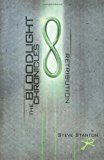Eternal Virus
 The Bloodlight Chronicles sci-fi trilogy postulates an “Eternal Virus” that vastly prolongs human life due to its rejuvenating effects. The intertwining tales focus on the source and control of this mysterious virus, as well as the social effects of selective medical immortality. In these three novels, the “Eternal Virus” concept serves as a double entendre relating to religious experience and the search for eternal life, based on my Superlight novella published in 1997. This was before the human genome was sequenced or gene editing became commonplace, but even in those early days, viruses were known to be crude vectors for transmitting genetic information. Viruses have the natural ability to hijack cells, insert their own DNA, and trick the cells into creating more copies of the virus. They have been around for millennia and have left a huge mark throughout the natural world. In fact, we understand now that a full 8 percent of the human genome is composed of DNA left behind by ancient retroviruses. That's 250 million letters hijacked into the human genetic code of over three billion DNA base pairs!
The Bloodlight Chronicles sci-fi trilogy postulates an “Eternal Virus” that vastly prolongs human life due to its rejuvenating effects. The intertwining tales focus on the source and control of this mysterious virus, as well as the social effects of selective medical immortality. In these three novels, the “Eternal Virus” concept serves as a double entendre relating to religious experience and the search for eternal life, based on my Superlight novella published in 1997. This was before the human genome was sequenced or gene editing became commonplace, but even in those early days, viruses were known to be crude vectors for transmitting genetic information. Viruses have the natural ability to hijack cells, insert their own DNA, and trick the cells into creating more copies of the virus. They have been around for millennia and have left a huge mark throughout the natural world. In fact, we understand now that a full 8 percent of the human genome is composed of DNA left behind by ancient retroviruses. That's 250 million letters hijacked into the human genetic code of over three billion DNA base pairs!We can think of the human genome as a piano keyboard with three billion keys. Each key is made up of a coupled pair of only four different building blocks, and these four nucleotides provide the code for only 20 amino acids, which are used to build the variety of proteins that create and sustain life. The basic code of the keyboard is quite simple, but the play of proteins on the keyboard is a complex symphony of molecular biology. Now the new CRISPR technology has unlocked the genetic code by using a cell's natural repair mechanism to insert nucleotides made to order. The four basic building blocks of DNA can be cut and pasted as easily as editing this document. In the words of discoverer Jennifer Doudna in her new book, A Crack in Creation, “CRISPR gives us the power to radically and irreversibly alter the biosphere that we inhabit by providing a way to rewrite the very molecules of life any way we wish.” Not only can we change any living creature, but we can resurrect extinct species or even create new organisms from scratch!
Editing the genetic code of sperm and egg cells or a fertilized zygote is relatively simple and inexpensive. Diseases can be eliminated from the host before they develop. Improvements can be tweaked before birth. Once this new technology gains traction, the human genetic code will be purified of error and natural conception will become archaic. Consider for a moment that every person experiences roughly one million DNA mutations per second as cells divide throughout the body, and each new baby begins life with over fifty random mutations from the parents' sperm and egg cells. Now, for the first time, humans have the technology to impose order on this roiling chaos that causes disease and premature death. Any delay in implementation will be judged unethical by future generations, when babies born with preventable diseases may well sue parents, midwives, and doctors for malpractice. As Doudna explains, “we are already supplanting the deaf, dumb, and blind system that has shaped genetic material on our planet for eons, and replacing it with a conscious, intentional system of human-directed evolution.”
But for an adult human whose genome is fixed and perhaps suffers from a debilitating illness, the chance for better health is not so simple. In this case, the CRISPR technology must be employed to change every cell in the effected system. A blood-borne illness will require every blood cell to be fixed. A hereditary vision impairment will require every cell in the eye to be corrected. In any disease caused by runaway mutation, every cancer cell must be targeted with precision. That's the forefront of medicine right now, and many public companies are undertaking this huge challenge and regularly publishing a deluge of experimental results. One of the most promising avenues of research comes from retooling viral vectors to deliver CRISPR payloads to specific areas and sneak new genetic material inside host cells. CRISPR technology can also be used to deliver protein payloads that force gene expression along the DNA keyboard without actually making any permanent changes. It doesn't take a sci-fi author to see that the “Eternal Virus” will soon be a reality. (And, curiously, the activated virus will glow green just like in my books, because of a green fluorescent jellyfish protein that is widely used worldwide to visualize components in the lab.) A whole family of viruses will be developed to cure specific diseases, and eventually one super-virus will have multitasking properties designed to repair cellular mutations and other damage related to aging in humans.
And so we come back to the questions raised in The Bloodlight Chronicles. Who will benefit from this emerging technology in an age of public healthcare scarcity? Will only the rich have disease-free babies and genetic enhancements? Will the One Percent control the genomic system as well as the financial system on planet Earth? Or perhaps only those politically connected to a secretive health community will have access to viruses individually tailored to their DNA. We can be sure that public insurance companies will not have the resources to pick up the tab. And what will happen when hackers start to tinker with the human genetic code in back-alley labs? Most of the CRISPR techniques so far are open source and widely published, and just as the advent of computer software galvanized a whole generation of coders to change our external world, we can expect human DNA to be the next big game.
Published on December 07, 2017 10:12
No comments have been added yet.



